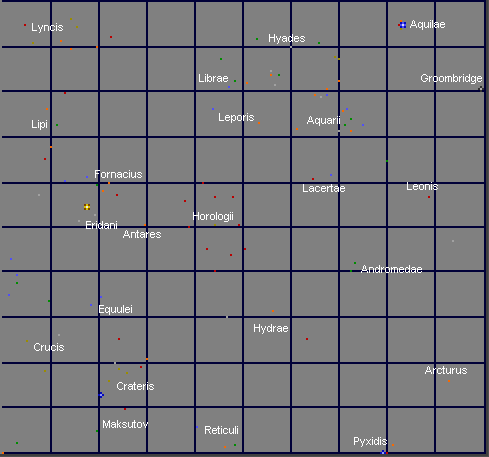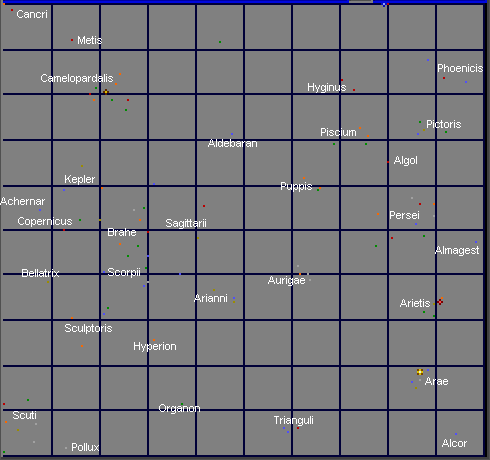Spoiler-Free Star Map: Difference between revisions
Melnorme has revealed lots of helpful information and corrected grammar and spelling errors |
just found out what the s |
||
| Line 3: | Line 3: | ||
These four charts comprise a map of the Ur-Quan universe, with various features named. It's basically a screen capture of the in-game starmap, but the names of all the star clusters, and those of some individual stars, have been added. This will make it easier for you when an NPC tells you "The ship is coming from the direction of Pollux" or "You should visit the Normae star cluster". Rather than having to cursor-hunt for the star across the whole map, you can just look on these charts! | These four charts comprise a map of the Ur-Quan universe, with various features named. It's basically a screen capture of the in-game starmap, but the names of all the star clusters, and those of some individual stars, have been added. This will make it easier for you when an NPC tells you "The ship is coming from the direction of Pollux" or "You should visit the Normae star cluster". Rather than having to cursor-hunt for the star across the whole map, you can just look on these charts! | ||
Remember, though, that as of version 0.5.0, you can hit the '/'-key whenever you're on the starmap to search for a star's name. If the '/' key is inconveniently placed on your keyboard, you may want to [[The Ur-Quan Masters Technical FAQ#How do I change my keys?|change your key bindings]]. | Remember, though, that as of version 0.5.0, you can hit the '/'-key whenever you're on the starmap to search for a star's name. If the '/' key is inconveniently placed on your keyboard, you may want to [[The Ur-Quan Masters Technical FAQ#How do I change my keys?|change your key bindings]]. This and earlier versions will display the name of the star, its co-ordinates, and the amount of fuel needed to get there when you use the arrow keys to center the star in the middle of the aiming cross. | ||
The charts are also on a gray, not black, background so that you can print them out and write notes on them. Any individual chart enlarged to 150% in size will fit on a standard piece of North American Letter-size paper when the margins are reduced to zero. Just be sure you are enlarging the picture from its full size, not the 87% reduced size. The | The charts are also on a gray, not black, background so that you can print them out and write notes on them. Any individual chart enlarged to 150% in size will fit on a standard piece of North American Letter-size paper when the margins are reduced to zero. Just be sure you are enlarging the picture from its full size, not the 87% reduced size. The chart of the region of space you start in is at the lower left, and goes under the filename "Uqm-starmap-nameslarge-SW.PNG", with "SW" standing for "southwest". As is conventional, the other charts have filenames of the same form, but with the cardinal direction letters replaced, in clockwise order, by NW, NE, and SE. This is to help you put the sheets back together if you print out the sheets separately. | ||
All of the screenshots and information on them come from a new game, ten seconds into it. There are no spoilers revealed in this map and nothing you wouldn't know when you start the game. | All of the screenshots and information on them come from a new game, ten seconds into it. There are no spoilers revealed in this map and nothing you wouldn't know when you start the game. | ||
| Line 11: | Line 11: | ||
The stars are of different colors. Some are depicted as dots, some are crosses, and some are squares with crosses in them. The significance of these distinctions you will have to find out for yourself. | The stars are of different colors. Some are depicted as dots, some are crosses, and some are squares with crosses in them. The significance of these distinctions you will have to find out for yourself. | ||
The geometric "Origin", or co-ordinate 0.0 : 0.0, is at the lower left of the chart at the lower left. The vertical and horizontal lines which subdivide the map are 50 units of distance apart, so the center of the four charts is at 500.0 : 500.0. You start at Sol, located at co-ordinates 175.2 : 145.0. That's three-and-a-half squares to the right of the Origin, and nearly three squares up. Each unit of fuel, regardless of the number of engines in your spaceship, will enable you to travel 10 units of distance. (More engines merely make you travel faster.) Thus, to travel from Sol to the aforementioned center of the charts, you would need about 48 units of fuel, plus another 48 to return, without accounting for any fighting, evading, escaping into a star system, or stopping for resource accumulation you would do on the way. This example is to help you gauge if you've taken on too big a journey for your gas tank. | The geometric "Origin", or co-ordinate 0.0 : 0.0, is at the lower left of the chart at the lower left. The vertical and horizontal lines which subdivide the map are 50 units of distance apart, so the center of the four charts is at 500.0 : 500.0. You start at Sol, located at co-ordinates 175.2 : 145.0. That's three-and-a-half squares to the right of the Origin, and nearly three squares up. Each unit of fuel, regardless of the number of engines in your spaceship, will enable you to travel 10 units of distance. (More engines merely make you travel faster.) Thus, to travel from Sol to the aforementioned center of the charts, you would need about 48 units of fuel, plus another 48 to return, without accounting for any fighting, evading, escaping into a star system, or stopping for resource accumulation you would do on the way. This example is to help you gauge if you've taken on too big a journey for your gas tank. Ane remember, the starmap command already mentioned above will give you the distance. However, the vertical and horizontal lines on the in-game map when you are in travelling in hyperspace are not 50 units of distance apart, but 20. | ||
However, each individual star is not named. For example, the name "Centauri" below and to the left of Sol, your starting location, stands for the | However, each individual star is not named on this chart. For example, the name "Centauri" below and to the left of Sol, your starting location, stands for the six stars Alpha, Beta, Gamma, Delta, Epsilon, and Zeta Centauri. Thus, you will still have to add detail to be able to cross off whichever stars you have visited, for example. The starmap command mentioned above will give you the name. And here's an astronomical note which might help you: "Alpha" is supposed to be the brightest star in any constellation, followed by "Beta," etc. | ||
A text list of stars and their co-ordinates can be found at [[Star Coordinates]]. | A text list of stars and their co-ordinates can be found at [[Star Coordinates]]. | ||
Revision as of 19:02, 12 May 2006
|
This page is guaranteed to be spoiler free. It is safe for you to read this page even if you have not completed playing The Ur-Quan Masters. Links you follow from this page do not share this guarantee unless they also include this text. |
These four charts comprise a map of the Ur-Quan universe, with various features named. It's basically a screen capture of the in-game starmap, but the names of all the star clusters, and those of some individual stars, have been added. This will make it easier for you when an NPC tells you "The ship is coming from the direction of Pollux" or "You should visit the Normae star cluster". Rather than having to cursor-hunt for the star across the whole map, you can just look on these charts!
Remember, though, that as of version 0.5.0, you can hit the '/'-key whenever you're on the starmap to search for a star's name. If the '/' key is inconveniently placed on your keyboard, you may want to change your key bindings. This and earlier versions will display the name of the star, its co-ordinates, and the amount of fuel needed to get there when you use the arrow keys to center the star in the middle of the aiming cross.
The charts are also on a gray, not black, background so that you can print them out and write notes on them. Any individual chart enlarged to 150% in size will fit on a standard piece of North American Letter-size paper when the margins are reduced to zero. Just be sure you are enlarging the picture from its full size, not the 87% reduced size. The chart of the region of space you start in is at the lower left, and goes under the filename "Uqm-starmap-nameslarge-SW.PNG", with "SW" standing for "southwest". As is conventional, the other charts have filenames of the same form, but with the cardinal direction letters replaced, in clockwise order, by NW, NE, and SE. This is to help you put the sheets back together if you print out the sheets separately.
All of the screenshots and information on them come from a new game, ten seconds into it. There are no spoilers revealed in this map and nothing you wouldn't know when you start the game.
The stars are of different colors. Some are depicted as dots, some are crosses, and some are squares with crosses in them. The significance of these distinctions you will have to find out for yourself.
The geometric "Origin", or co-ordinate 0.0 : 0.0, is at the lower left of the chart at the lower left. The vertical and horizontal lines which subdivide the map are 50 units of distance apart, so the center of the four charts is at 500.0 : 500.0. You start at Sol, located at co-ordinates 175.2 : 145.0. That's three-and-a-half squares to the right of the Origin, and nearly three squares up. Each unit of fuel, regardless of the number of engines in your spaceship, will enable you to travel 10 units of distance. (More engines merely make you travel faster.) Thus, to travel from Sol to the aforementioned center of the charts, you would need about 48 units of fuel, plus another 48 to return, without accounting for any fighting, evading, escaping into a star system, or stopping for resource accumulation you would do on the way. This example is to help you gauge if you've taken on too big a journey for your gas tank. Ane remember, the starmap command already mentioned above will give you the distance. However, the vertical and horizontal lines on the in-game map when you are in travelling in hyperspace are not 50 units of distance apart, but 20.
However, each individual star is not named on this chart. For example, the name "Centauri" below and to the left of Sol, your starting location, stands for the six stars Alpha, Beta, Gamma, Delta, Epsilon, and Zeta Centauri. Thus, you will still have to add detail to be able to cross off whichever stars you have visited, for example. The starmap command mentioned above will give you the name. And here's an astronomical note which might help you: "Alpha" is supposed to be the brightest star in any constellation, followed by "Beta," etc.
A text list of stars and their co-ordinates can be found at Star Coordinates.
 |

|
 |

|